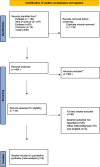Meta-analysis: clinical outcomes of laser-assisted in situ keratomileusis (LASIK) and photorefractive keratectomy (PRK) in hyperopia
- PMID: 40102791
- PMCID: PMC11917003
- DOI: 10.1186/s12886-025-03956-6
Meta-analysis: clinical outcomes of laser-assisted in situ keratomileusis (LASIK) and photorefractive keratectomy (PRK) in hyperopia
Abstract
Background: To evaluate differences in clinical outcome, safety, and efficacy of photorefractive keratectomy (PRK) and laser-assisted in situ keratomileusis (LASIK) in the correction of hyperopic refractive errors.
Methods: We have adhered to PRISMA criteria in this systematic review, which is registered with PROSPERO (CRD42023469543). Our search with studies comparing PRK and LASIK for hyperopia was conducted through the databases PubMed, EMBASE, Web of Science, and the Cochrane Library. We used the Cochrane method to assess bias and evaluated variables like uncorrected distance visual acuity and mean spherical equivalent. Using fixed- or random-effects models, a meta-analysis was performed using RevMan 5.4 for evaluating heterogeneity and significance. Sensitivity analysis addressed the causes of heterogeneity to assure stability.
Results: We included 6 articles (419 participants, 585 eyes) in this review five were retrospective and 1 case-series. The final mean refractive SE (WMD, -0.05; 95% confidence interval [CI], 0.42 to 0.31; P = 0.06). patients achieving uncorrected distance visual acuity (UDVA) of 20/20 or better (OR, 0.58; 95% CI, 0.39-0.78; P = 0.33). final UDVA of 20/40 or better (OR, 1.40; 95% CI, 0.65-3.02; P = 0.81) were analyzed.
Conclusions: In this meta-analysis, LASIK had no significant benefits over PRK in relation to clinical outcomes. Less corneal haze was observed in LASIK-treated eyes at 1 to 3 months after surgery.
Keywords: Hyperopia; LASIK; Laser-assisted in situ keratomileusis; PRK; Photorefractive keratectomy; Refractive surgery.
© 2025. The Author(s).
Conflict of interest statement
Declarations. Ethics approval and consent to participate: Not applicable. Consent for publication: Not applicable. Competing interests: The authors declare no competing interests.
Figures














References
-
- Wagh VK, Dave R, O’Brart DP, Lim WS, Patel P, Tam C, Lee J, Marshall J. Eighteen-year follow-up of hyperopic photorefractive keratectomy. J Cataract Refract Surg. 2016;42(2):258–66. 10.1016/j.jcrs.2015.09.025. - PubMed
-
- Swinger CA. Comparison of results obtained with keratophakia, hypermetropic keratomileusis, intraocular lens implantation, and extended-wear contact lenses. Int Ophthalmol Clin. 1983;23(3):59–74. 10.1097/00004397-198302330-00008 - PubMed
-
- Asroui L, Arba-Mosquera S, Torbey J, Ahmed MA, Fattah MA, Koaik M, Awwad ST. Long-Term Results of Hyperopic Ablations Using Alcohol-Assisted PRK and Femtosecond Laser-Assisted LASIK: A Comparative Study. J Cataract Refract Surg. 2022;13:10–97. - PubMed
-
- El-Agha MS, Johnston EW, Bowman RW, Cavanagh HD, McCulley JP. Photorefractive keratectomy versus laser in situ keratomileusis for the treatment of spherical hyperopia. Eye Contact Lens. 2003;29(1):31–7. 10.1097/00140068-200301000-00009. - PubMed
Publication types
MeSH terms
LinkOut - more resources
Full Text Sources

